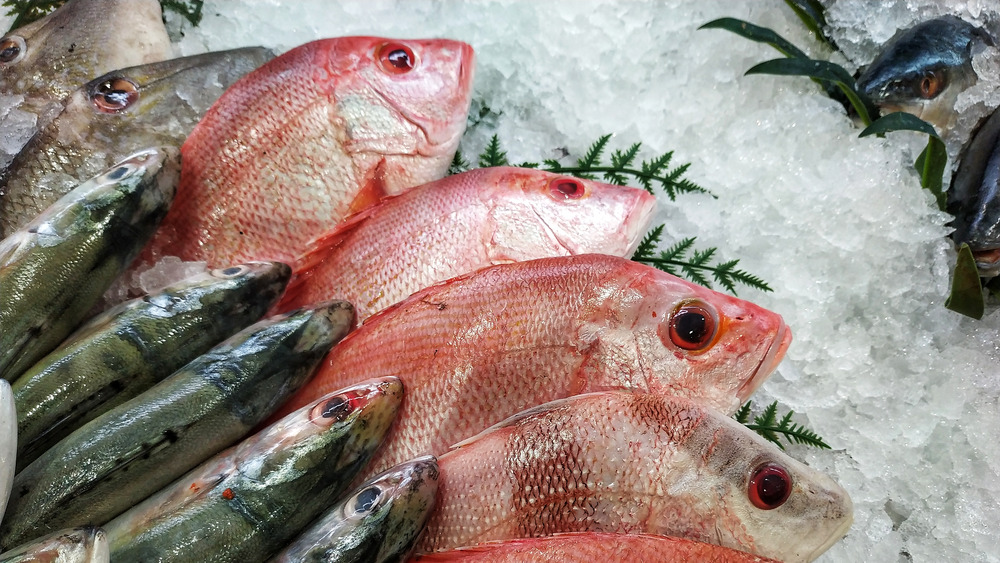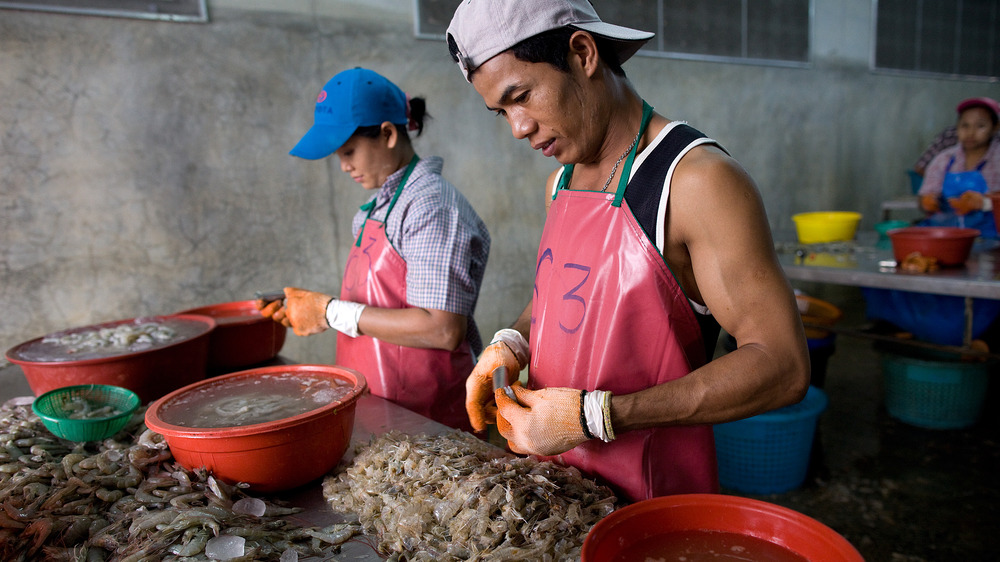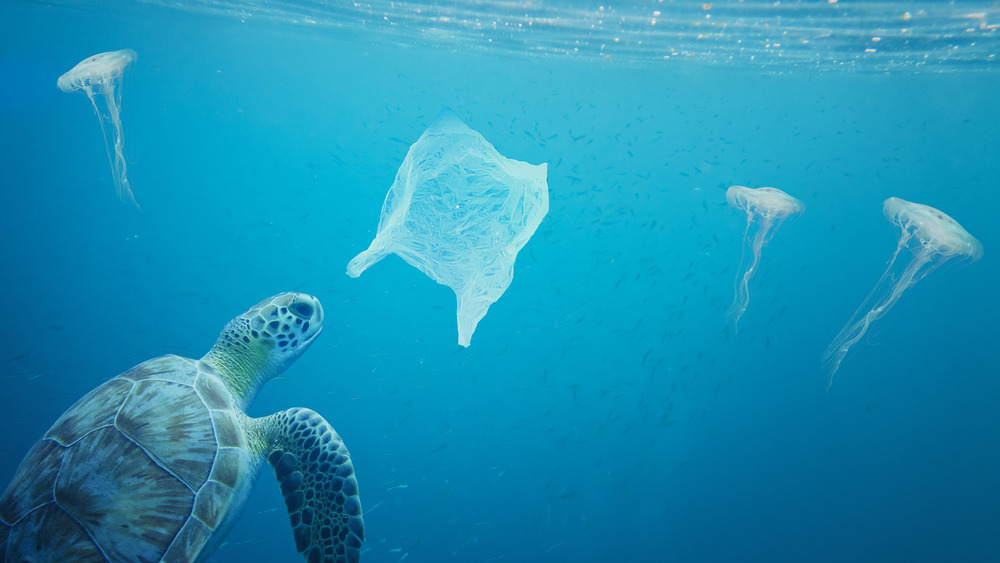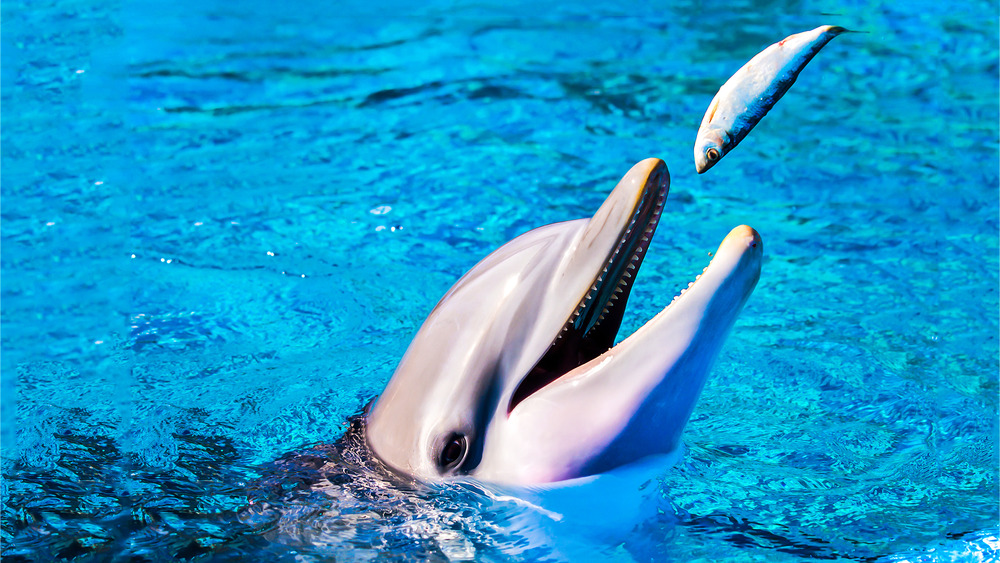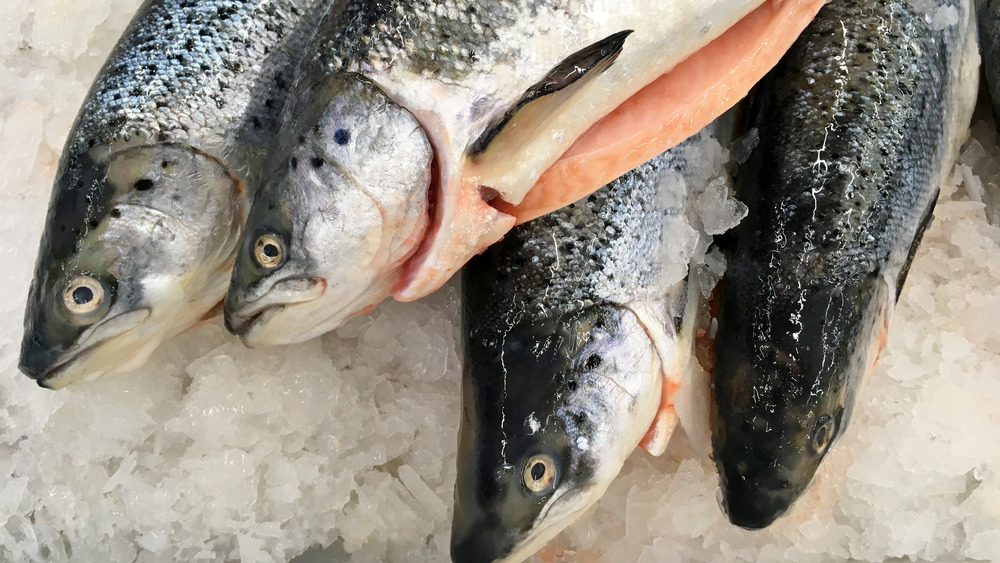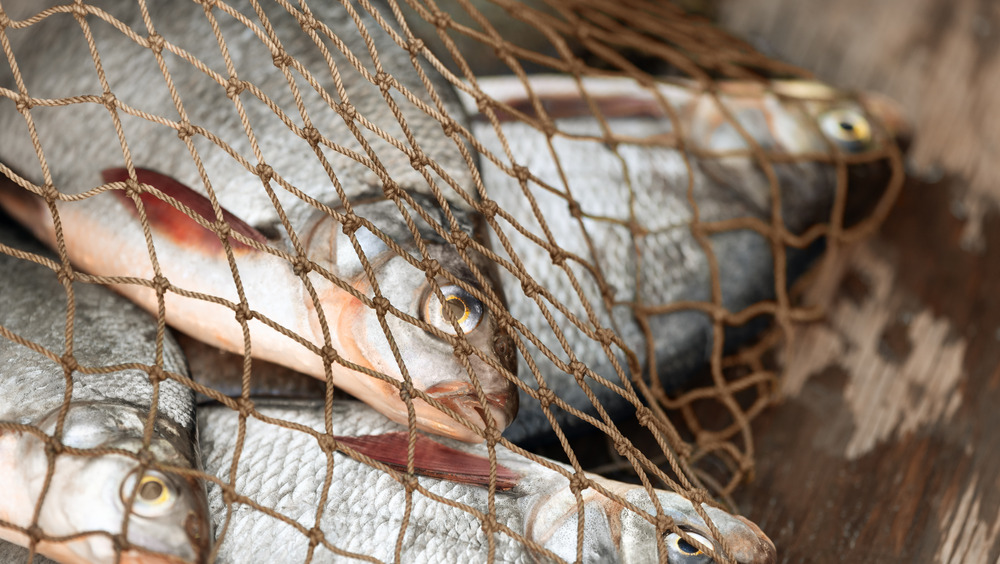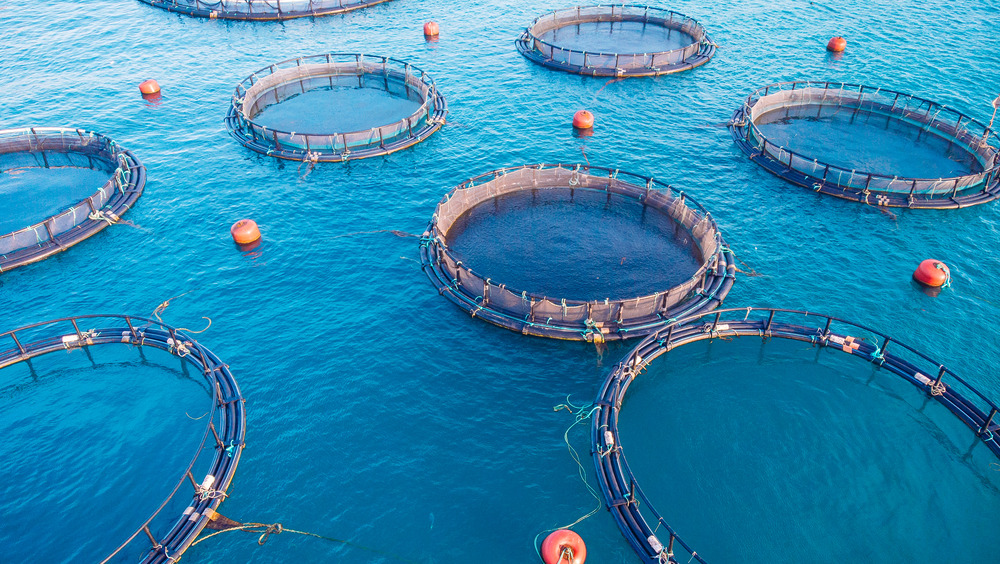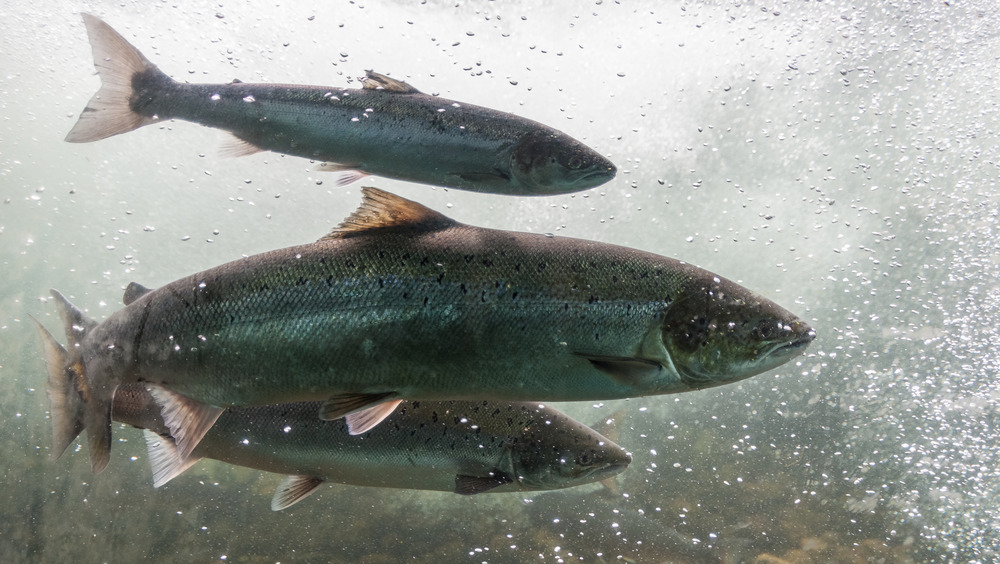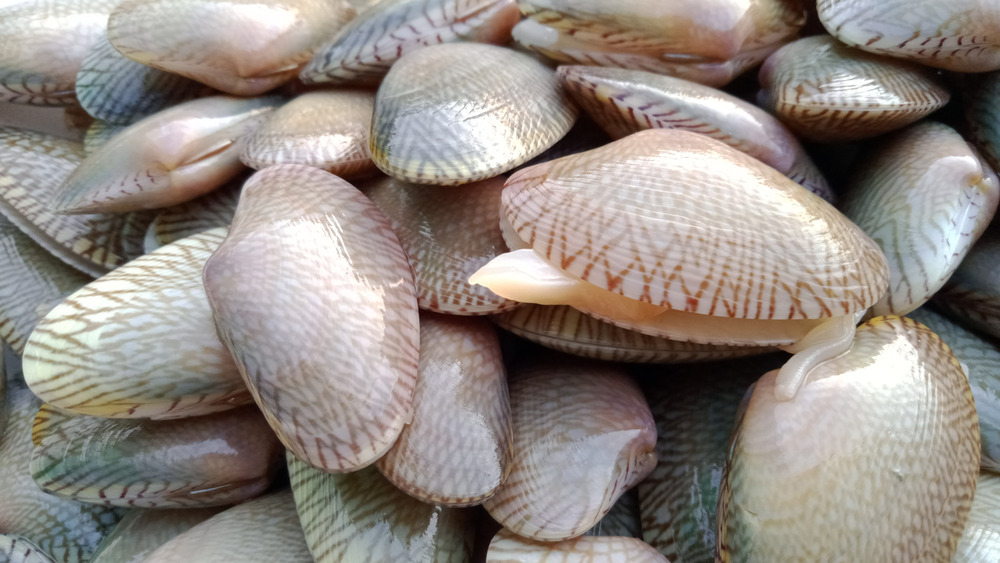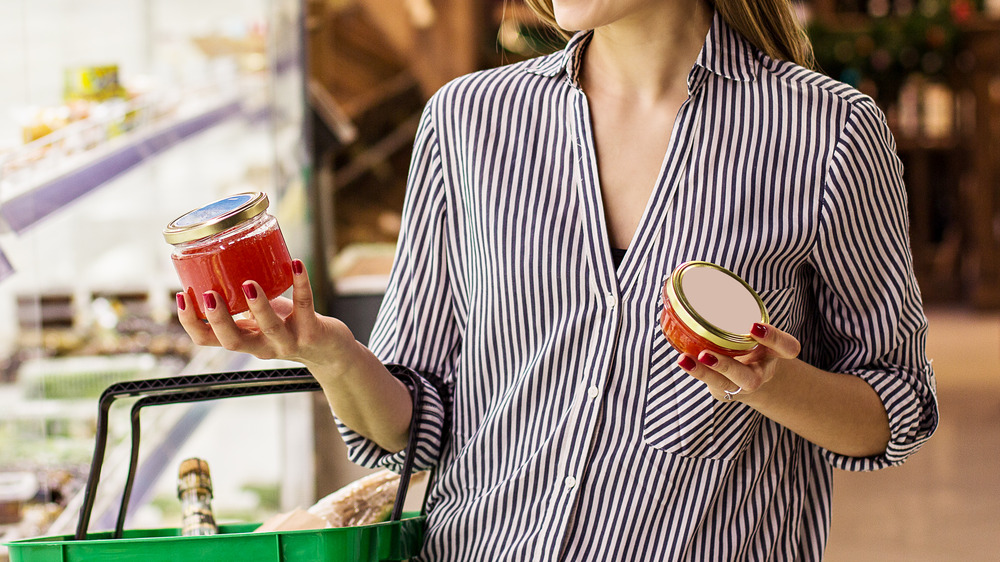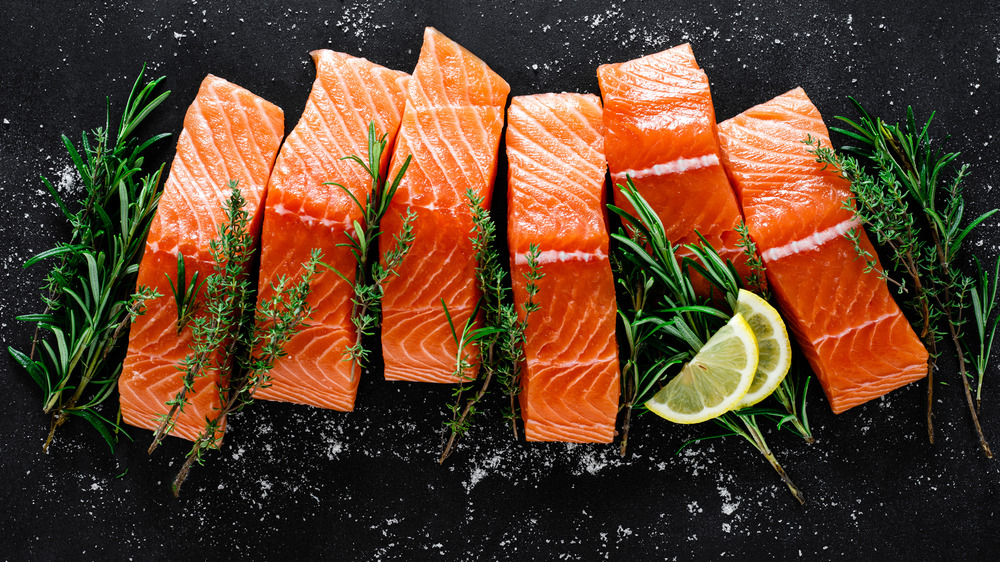The Shady Truth About The Seafood Industry
You've likely heard that fish is good for your health, with it being rich in omega 3 fatty acids that can contribute to better brain health. You've probably also heard that seafood is high in minerals like selenium, a known immune booster and an essential compound for heart health. And you've likely even heard that eating fish and seafood is a better choice from an environmental perspective, as compared to meat and poultry, and that it could reduce your carbon footprint.
But the waters of the seafood industry are murky, and there's more to it than meets the eye.
The seafood industry has long been problematic, with issues such as overfishing and contamination leading to unhealthy fish and unhealthy oceans (via WWF). But as climate change worsens and our global taste for seafood increases, these issues are becoming even more dire. Here's what you need to know about what's really going on behind your local fish counter or sushi bar.
Your supermarket shrimp might be peeled by slaves
Seafood isn't an easy thing to prepare without a bit of assistance. While fishmongers will readily fillet, debone, and skin your fish for you, sometimes it feels easier to just grab a frozen bag of peeled shrimp and call it a day. But be wary when you do: In 2015, an Associated Press investigation found that much of the peeled shrimp sold in supermarkets in the U.S., Europe, and Asia was peeled by slaves in Thailand, some of whom were young children so small they had to stand on stools to reach the peeling tables.
We think you'll agree that it's worth the added effort of peeling your own shrimp at home — with this handy hack in tow — if it means steering clear from these horrendous practices (and as if you needed another reason, those shrimp shells make a lovely homemade shrimp stock). Seek out Fair Trade-certified shrimp for even more assurance that yours are coming from a sustainable, humane source.
Pollution might be contaminating your seafood
Considering fish ingest pollution in the ocean, plastics might be reaching our digestive systems through seafood, but research on this issue is complicated and as of early 2021, had not come to clear conclusions or warnings.
On the one hand, it's difficult to know whether the fish you're eating could contain harmful plastic, but Chelsea Rochman, a UC Davis researcher, told NPR that "a lot of people are eating seafood all the time, and fish are eating plastic all the time, so I think that's a problem."
A study Rochman co-authored with Johns Hopkins University researchers found that microplastics, or tiny particles of plastic, are being ingested by seafood of all types, including shellfish. The study authors said further studies on the affects of microplastics on humans are "a critical priority."
Humans already ingest plastic from other sources, like bottled water and sea salt, Forbes reports. This adds some complication to the puzzle. A 2021 Australian study was also unable to pinpoint how exactly microplastics affect humans, the Australian Broadcasting Corporation (ABC) reported. However, microplastics could change in structure while in the ocean and interact with human systems — but again, research is still ongoing.
"Unless you understand where the plastic is coming from, what size it is, what particular plastic it is, and how it's been formed, it's really hard to understand whether it's going to pose any threat," Kevin Thomas, director of the Queensland Alliance for Environmental Health Sciences, told Australia's ABC.
Bycatch is killing sharks and dolphins
Many industrial fishing methods have a hard time targeting only the fish they seek. As a result, other species get caught in nets or trawls, including seabirds, turtles, and sea mammals, resulting in unnecessary animal deaths. In the worst cases, according to one report, up to six pounds of non-target species are discarded for every pound of shrimp caught. The organization also estimates that several shark species are endangered — with 80 to 90 percent of some shark types completely depleted — due to bycatch.
To ensure that the fish you're buying aren't part of this devastating cycle, look for fish caught with more sustainable and eco-friendly methods, like pole-and-line caught tuna or shrimp caught in nets using Turtle Excluder Devices (TED). There's no one-size-fits-all solution, so you'll need to do a deep dive (har-dee-har) to ensure that you're choosing the right fishing method for the fish on your shopping list. Try the Monterey Bay Aquarium's Seafood Watch program for more info about individual species.
Overfishing for seafood is messing with the natural balance of the ocean
Overfishing is a problem that results in fish being taken out of the water more quickly than they can naturally be replaced by reproduction cycles. And it's a rampant issue around the world, despite legislation attempting to reduce it. According to the United Nations Food and Agriculture Organization, over 90% of the world's fisheries are currently either "fully exploited, overexploited or depleted."
In-demand large fish like tuna and snapper are particularly vulnerable to overfishing, as they take even longer to reproduce than smaller fish like anchovies and sardines. Industry experts have been pushing chefs and diners alike to stop eating bluefin tuna for the foreseeable future in order to allow these stocks to bounce back after years of overfishing. Choosing to eat smaller fish, then, can make a big difference in reducing overfishing and protecting these endangered species.
International fishing management is rife with scandal and secrecy
Illegal fishing is rampant around the world, particularly as fish species become depleted and demand only continues to rise. According to the World Wildlife Fund, illegal fishing is a key driver of overfishing around the world, and it's almost impossible to detect. The WWF nevertheless estimates that global losses of illegal fishing amount to somewhere in the ballpark of $36.4 billion per year, and since the methods of illegal fishermen are usually far from sustainable, losses to ecosystems are likely devastating as well.
Illegal fishing is, by its very definition, a murky subject. The best way consumers can avoid accidental run-ins with the illegal fishing trade is by demanding the most transparent and traceable sourcing for their seafood. Transparency standards are improving every day, but as WWF shows, there's still a long way to go. Don't be afraid to ask questions about the origins of your fish and seafood, and if something seems fishy... move on.
Farmed fish isn't necessarily better for the environment
After learning more about how fish and seafood is caught around the world, it could seem tempting to resort to farmed seafood — but this usually isn't any better. Not only is farmed fish not as nutritious as wild caught fish, it is often raised in subpar standards: fed near-constant courses of antibiotics and succumbing frequently to diseases and parasites. And since many fish farms are penned in the oceans, bacteria or escapees can actually infect wild populations as well.
This isn't the case of all farmed seafood. In fact, great strides have been taken of late to improve aquaculture practices, including engineering vegetarian fish food for even carnivorous species or creating closed loop "aquaponic" systems, where fish and plants grow in harmony in a mutually beneficial hydroponic-aquaculture settings. More work must be done in this arena, however, if farmed fish is to be a healthful, sustainable alternative to wild.
Aquaculture can be inefficient when it comes to salmon
When it comes specifically to carnivorous fish like salmon, farming is not a sustainable way to source. Salmon in the wild feast on small fish, and in a farmed environment, this species needs up to five pounds of smaller fish, like anchovies and herring, for each pound of body weight brought to market. Do the math: That means a five-fold protein loss, which is inefficient and unsustainable to boot.
But as we previously explored, consuming large, carnivorous fish depletes their availability due to chronic overfishing. And so, you might want to broaden your seafood scope: Salmonids like trout and Arctic char can be good alternatives to salmon, while smaller, oily fish like mackerel and sardines provide many of the same omega-3 fatty acids without the same impact on depleted salmon stocks.
If you do choose farmed salmon, look for products certified by the Aquaculture Stewardship Council. Fish farms bearing this recognition have committed to reducing pollution, limiting the use of medications and chemicals, and improving working conditions for farm employees, among others.
The oceans are warming and acidifying, which could affect your seafood options
Due to increasing global temperatures, the oceans are warming, which can have devastating effects on the complex ecosystems that reside within them. Ocean acidification is an incredible stressor, in particular, on species that use calcium carbonate to build their skeletons and shells. Animals in this category include mollusks like clams and mussels as well as crustaceans like crabs. Since they're not as able to build their protective outer shell, these animals are more at-risk for attacks from predators, which means that when we, as humans and diners, prey on them, we risk reducing their numbers even further.
Luckily, shellfish are some of the few marine animals that can be effectively and sustainably farmed. Choosing farmed mussels is a great way for consumers to reduce putting pressure on wild shellfish stocks, and reducing our carbon footprints however we can may help slow the effects of climate change on our oceans.
It can be confusing to find sustainable seafood
Of course, there are some seafood options that are better than others, such as farmed fish fed algae or pole-and-line caught tuna. But it can be almost impossible to figure out which is which at the supermarket or on a restaurant menu, with one NPR exposé showing just how hard it can be to get a straight answer when attempting to shop sustainably.
Not only is fish and seafood labeling often confusing and unclear, occasionally, it's a downright scam, with one analysis of 44 studies finding that nearly 40% of 9,000 products from fishmongers, restaurants, and markets were mislabeled.
Unfortunately, this is a problem plaguing many consumer goods today, from fashion to coffee to produce. Apps like Monterey Bay Aquarium's Seafood Watch and labels like Aquaculture Stewardship Council can help guide you towards better products, but it's also important to ask questions and do your own research.
GMO salmon is joining the party
One new product to the U.S. market, genetically engineered AquaBounty salmon, has been met with much chagrin. The salmon, which would be the first genetically engineered animal allowed for human consumption in the U.S., was engineered by splicing genes from faster-growing fish into the salmon genome. The resulting salmon grows more quickly than its wild counterpart, getting it to market more quickly and efficiently.
This could be perceived as a good thing. After all, regular salmon stocks are highly demanding in terms of feed. But environmentalists worry that the salmon will risk contaminating wild populations, despite vehement claims to the contrary from the company. And due to loopholes in U.S. GMO labeling legislation, it could slip onto consumers' plates without their knowledge.
For now, AquaBounty CEO Sylvia Wulf says she is committed to labeling despite a lack of government oversight, so that might be one positive.
